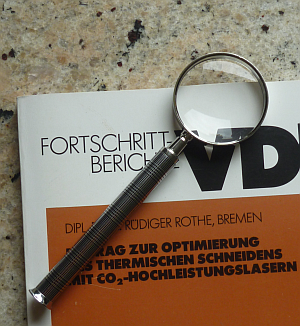Detailed Contents
The following detailed table of contents is deeply divided. There the terms and thus the areas of expertise are named, used in the specific field of production laser technology. The nesting depth leads virtually to an index of technical terms.
The terms are used also to deepen the knowledge of literature. As far as the understanding required, they are also defined under the numbered chapters. The definitions are those standardized in DIN in a few exceptions. The main headings of this directory are included in the chapter "Outline". There, they can individually be called up, similar to here.
1 Overview of Materials Processing Methods using Laser Beams
1.1 Classification of Methods and Manufacturing Techniques
1.2 Zuordnung der Verfahren zu denen der Fertigungstechnik
2 The Laser Beam as Tool
2.1 Beam Properties
2.1.1 Wavelength
2.1.2 Power
2.1.3 Duty cycle (switch-on time)
2.1.5 Beam Caustic
2.1.5 Diameter
2.1.6 Divergency
2.1.7 Beam Waist
2.1.8 Invariant
2.2 Gaussian Beams
2.2.1 Stable Resonators
2.2.2 Stability Criteria
2.2.3 Longitudinale Modes
2.2.4 Transversale Moden
2.3 Other Beams
2.3.1 Instable Resonators
2.3.2 Coupling Out
2.3.3 Pros and Cons
2.4 Beam Transformation
2.4.1 Imaging Laws, Comparison to Geometrical Optics
2.4.1.1 Diametre-Transformation
2.4.1.2 Longitudinal Transformation
3 The Material
3.1 Optical Properties
3.1.1 Homogenity
3.1.2 Transparency
3.1.3 Refraction Indices
3.2 Thermophysical Properties
3.2.1 Heat Capacity
3.2.2 Heat Conduction
3.2.3 Thermal Diffusivity
3.3 Heat Conduction
3.3.1 Stationary Heat Conduction
3.3.2 Non-Stationary Heat Conduction
3.3.3 Relaxation Equation
3.4 Phase Transformations
3.5 Diffusion
3.6 Chemical Properties
3.6.1 Thermochemical Properties
3.6.1.1 Reaction Enthalpy
3.6.2 Photochemical Properties
3.7 Mechanical and Technical Properties
3.7.1 Microstructure Transitions
3.7.2 Hardness Increase
3.7.3 Cracking
4 Interaction between Laser Beam and Material
4.1 Absorption in the Surface Layer
4.1.1 Absorption Capacity
4.1.2 Heating
4.1.3 Heat Effect
4.1.4 Chemical Effect
4.2 Absorption in Interior
4.2.1 Optically Clear Materials
4.2.1.1 Absorption Capacity
4.2.1.2 Heating
4.2.1.3 Heat Effect
4.2.1.4 Chemische Wirkung
4.2.2 Optical Turbid Materials
4.2.2.1 Scattering
5 The Processing
5.1 Laser Plant
5.1.1 Laser Unit
5.1.2 Laseran Assembly
5.1.3 Laser
5.1.4 Laser Resonator
5.2 Laser devices for Materials Processing
5.2.1 The CO2-Laser, Design Engineering and Properties
5.2.1.1 Wave-Guide-Laser
5.2.1.2 Slow Flow Laser
5.2.1.3 Fast Flow Laser
5.2.1.4 Continuous Wave (CW) Laser
5.2.1.5 Pulse-Laser
5.2.1.6 TEA-Laser
5.2.2 The Nd-Laser, Design Engineering and Properties
5.2.2.1 The Nd-Yag-Laser
5.2.2.2 The Nd-Glas-Laser
5.2.2.3 Rod Laser
5.2.2.4 Disc Laser
5.2.2.5 Continuous Wave (CW) Laser
5.2.2.6 Puls Laser
5.2.3 The Diode Laser
5.2.3.1 Beam Properties
5.2.4 The Fibre Laser
5.2.4.1 Beam Properties
5.2.5 The Excimer-Laser, Design Engineering and Properties
5.2.5.1 Beam Properties
5.2.5.2 Wellenlängen-Bereiche
5.2.5.3 Pulsse Length
5.3 Guiding Machines
5.3.1 Beam-Guiding and Forming
5.3.1.1 Guiding by Mirror Optics
5.3.1.1.1 Influences of long Beam Paths
5.3.1.2 Guiding by Fibres
5.3.1.2.1 Influences of the Fibres on Beam
5.3.1.3 Beam Forming Components
5.5 Machine type
5.5.1 Required Axes
5.5.2 Nomenclature
5.5.3 Design Engineering
5.5.3.1 Moving Tool
5.5.3.2 Moving Workpiece
5.5.3.3 Hybrid Systems
5.5 Examples of Laser Plants
5.5.1 Needs from Processing Parameters
5.5.1.1 Speed
5.5.1.2 Acceleration
5.5.1.3 Precision of Trajectory
6 The Individual Processing Methods
6.1.1 Basics
6.1.1.1 Information from Heat Conduction Equations
6.1.1.2 Temperature Field
6.1.1.3 Balance of Power
6.1.1.5 Beam Forming Optics
6.1.1.5 Laser-Beam Hardening
6.1.1.6 Laser-Beam-Remelting
6.1.1.6.1 Remelting by Heat Conduction
6.1.1.6.2 Remelting by Vapor Channel
6.1.1.7 Laserbeam-Alloying
6.1.1.7.1 Classification by Aggregate State
6.1.1.8 Laserbeam-Cladding
6.1.1.8.1 One-Stage Techniques
6.1.1.8.2 Two-Stage Techniques
6.2 Joining Methods
6.2.1 Laser-Beam-Brazing and Soldering
6.2.1.1 Laserbeam-Soldering
6.2.1.1.1 Basics of the Technology
6.2.1.1.2 Applications
6.2.1.2 Laserbeam-Brazing
6.2.1.2.1 Basics of the Technology
6.2.1.2.2 Applications
6.2.1.3 Laserbeam-High Temperature Brazing
6.2.1.3.1 Basics of the Technology
6.2.1.3.2 Applications
6.2.2 Laserbeam-Welding
6.2.2.1 Terminology from Welding Technology
6.2.2.1.1 Weldability of Components
6.2.2.1.2 Classification of Methods according to Aggregate State
6.2.2.2 The Laser Beam-Pressure Welding
6.2.2.2.1 Physical Background
6.2.2.2.2 Coupling Mechanisms
6.2.2.2.3 Focusing of the Laser Beam
6.2.2.2.4 Welding Devices
6.2.2.3 Laser-Beam Transmission Welding
6.2.2.3.1 Physical Background
6.2.2.3.2 Welding Process
6.2.2.4 Laser-Beam Fusion Welding (Heat Conduction Welding)
6.2.2.4.1 Results from Model Calculations
6.2.2.4.1.1 Coupling Mechanisms
6.2.2.4.1.2 Focusing the Laser Beam
6.2.2.4.1.3 Selection of Optics
6.2.2.4.1.4 Geometry of the Seam Cross Section
6.2.2.4.2 Welding Device
6.2.2.4.2.1 Welding Optics
6.2.2.4.3 Welding Process
6.2.2.5 Laser Beam-Vapour Welding (Deep Penetration Welding)
6.2.2.5.1 Physical Background
6.2.2.5.1.1 Vapor Channel
6.2.2.5.1.2 Results from Model Calculation
6.2.2.5.1.3 Coupling Mechanisms
6.2.2.5.1.4 Resonance Absorption
6.2.2.5.1.5 Focusing the Laser Beam
6.2.2.5.2 Selection of Optics
6.2.2.5.2.1 Fokus Position
6.2.2.5.3 Geometry of the Seam Cross Section
6.2.2.5.4 Welding Device
6.2.2.5.4.1 Welding Optics
6.2.2.5.4.2 Auxiliary Materials
6.2.2.5.4.2.1 Feed and Effect
6.2.2.5.4.3 Welding Consumables
6.2.2.5.4.3.1 Wire-Feed
6.2.2.5.5.3.2 Arrangements
Cutting Methods
6.3.1 Laserbeam-Cutting
6.3.1.1 Classification of Cutting Methods
6.3.1.2 Basics of the Methods
6.3.1.2.1 Sub process Heating
6.3.1.2.1.1 Influence of the Laser Beam
6.3.1.2.1.2 Influence of the Cutting Jet
6.3.1.2.2 Sub process Kerf Formation
6.3.1.2.2.1 Influence of the Cutting Jet
6.3.1.2.2.2 Entering into Kerf
6.3.1.3 Results from Calculation
6.3.1.3.1 Balance of Power to Heating
6.3.1.3.1.1 Minimum Power
6.3.1.3.1.2 Maximum Cutting Speed
6.3.1.3.2 Balance of Momentum to Kerf Formation
6.3.1.3.2.1 Maximum Cutting Speed
6.3.1.3.3 Optimisation Conditions
6.3.1.3.3.1 Laser-Beam
6.3.1.3.3.2 Cutting Jet
6.3.1.4 Design Engineering of Industrial Cutting Units
6.3.1.4.1 Layout
6.3.1.4.2 Distance Controll
6.3.1.4.3 Controll of Laser-Beam
6.3.2 Laser-Beam-Cracking
6.3.2.1 Cracking by Thermal-Shock
6.3.2.1.1 Basics of Technology
6.3.3 Laser-Beam-Removal
6.3.3.1 Removal using Focussed Beams
6.3.3.1.1 Physical Basics
6.3.3.1.2 Results from Calculations
6.3.3.1.2.1 Laser-Beam-Shape-Removal
6.3.3.1.2.2 Laser-Beam-Oscillation-Removal
6.3.3.1.2.3 Laser-Beam-Deep-Removal
6.3.3.1.3 Removing Machines
6.3.3.1.4 Examples of Use
6.3.3.2 Removal by Mask-Techniques
6.3.3.2.1 Physical Basics
6.3.3.2.1.1 Model Considerations
6.3.3.2.2 Removing Machines
6.3.3.2.3 Examples of Use
6.3.3.3 Drilling Using Laser-Beams
6.3.3.3.1 Drilling Using Stationary Beams (Channel Drilling)
6.3.3.3.2 Trepanning Using Moving Beams (Core Drilling)
6.4 Changing Material Properties
6.4.1 Laser-Beam-Verglasen
6.4.1 Laser-Beam-Remelting
6.4.2 Laser-Beam-Hardening
6.4.3 Laser-Beam-Tempering
6.4.4 Laser-Beam-Marking
6.4.5 Changing of Refraction
6.4.6 Transformation to Conductive Paths
6.4.8 Ferrite-Austenite-Transformation
6.4.9 Strain-Hardening of Rim Layers (Ablation Pressure)
6.5 Laser-Beam-Primary-Shaping
6.5.1 Stereo-Litography
6.5.1 Laser-Beam-Sintering
6.5.2 Selektives Melting using a Laser-Beam
6.5.3 Laser-Beam Free-Form Welding
6.5.4 Laminated Object Manufacturing
6.6 Laser-Beam-Metal-Forming
6.6.1 Thermal Metal-Forming Using Laser-Beams 6.6.2 Thermal Flattening Using Laser-Beams 6.6.3 Mechanical Metal-Forming Using Laser-Beams (Ablation Pressure)
